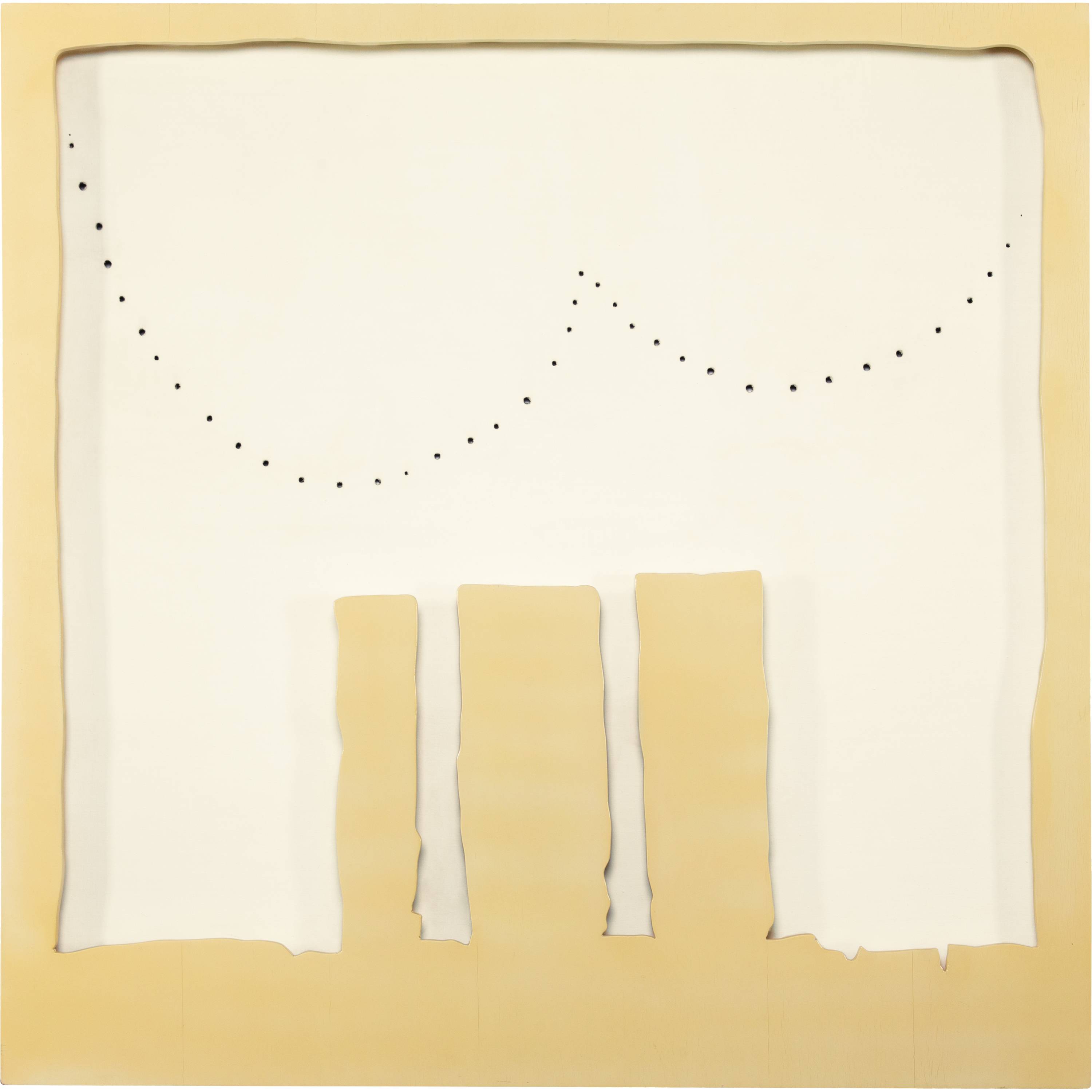- EN
Log in
- Live Auctions
- Past auctions
- More
- Gallery
- Art Dealing
- Publishing
- Kornfeld today
- The Story of Kornfeld
- Information
Note: The image cannot be displayed for legal reasons. For more information, see the PDF of the catalogue: Link to PDF
Rosario de Santa Fé 1899 - 1968 Comabbio
1966
Watercolours on canvas and lacquer paint over wood
110x110 cm
Signed and titled on the reverse of the canvas by the artist in brown "L. Fontana / "Concetto Spaziale"" and marked with directional arrows
Enrico Crispolti, Lucio Fontana, Catalogo Generale, vol. II, Milan 1986, no. 66 TE 25
Private collection, Milan
Auction Finarte, Milan, 8 June 1976, lot 68
International Private Collection
Galerie Dominique Lévy, with label
Private collection Monaco
Enrico Crispolti, Lucio Fontana, Catalogue Raisonné des peintures, sculptures et environments spatiaux rédigé, vol. II, Brussels 1974, pag. 176-177, no. 66 TE 25, reprod.
Germano Celant, Lucio Fontana, Ambienti Spaziali, Milan 2012, pag. 337, no. 363 (dated 1965 there).
Luca Massimo Barbero/Charlotte Call, Lucio Fontana: I Teatrini, London 2018, pag. 27, 28, 69, reprod.
Tokyo 1986, Fuji Television Gallery, Fontana, cat. no. 21, with label
Madrid 1987, Galería Theo, Fontana, Obras 1960-1968, cat. no. 1, with label
London 2018, Nahmad Projects, Lucio Fontana: I Teatrini, pag. 27, 28, 69, reprod.
In very good condition, the lacquered wood with fine cracks in places
Lucio Fontana is one of the most important Italian avant-garde artists of the post-war generation. In 1946, he published "Manifiesto blanco" in Buenos-Aires, in which he explained his theory of "Spazialismo". Fontana was in search of a new experience of space not only for sculpture but also for painting. He founded the "Movimento Spaziale" movement in 1947 and from then on his works served to illustrate a certain "Concetto spaziale", a concept of space. Holes, perforations and slits become typical features of his art, which he takes up in various groups of works, including: Buchi (Holes, from 1949), Pietre (Stones, 1952-56), Olii (Oil Paintings, from 1957), Tagli (Cuts, from 1958), Nature (1959-60), Metalli (1961-65), Fine di dio (1963-1964), Teatrini (Puppet Theatre, 1964-1966) and Ellissi (1967). In all these works, he is concerned with opening up spaces, piercing the canvas with sharp implements or cutting through the canvases with a sharp knife
A special group are the "Teatrini", the so-called "Puppet Theatres", which he executed from 1964-1966 and which are characterised by a moulded frame made of lacquered wood and a monochrome background riddled with holes. In the present work, the artist has designed the frame with three rectangles of almost the same size but different widths at the bottom centre in front of a white canvas with cloud-like curved perforated lines. In this work, Fontana plays impressively with the idea of space, but also with the idea of the stage. Thus, by advancing the composition, he creates a new three-dimensional space that keeps changing depending on the shadow. There are about 180 works from the "Teatrini" series; compared to works from other larger and better-known groups of works, they are rather rare and represent a fascinating peculiarity in the artist's oeuvre
1966
Wasserfarben auf Leinwand und Lackfarbe über Holz
110x110 cm
Rückseitig auf der Leinwand vom Künstler in Braun signiert und betitelt "L. Fontana / "Concetto Spaziale"" und mit Richtungspfeilen gekennzeichnet
Enrico Crispolti, Lucio Fontana, Catalogo Generale, Bd. II, Mailand 1986,
Privatsammlung, Mailand
Auktion Finarte, Mailand, 8. Juni 1976, Los 68
Internationale Privatsammlung
Galerie Dominique Lévy, mit Etikett
Privatsammlung Monaco
Enrico Crispolti, Lucio Fontana, Catalogue Raisonné des peintures, sculptures et environments spatiaux rédigé, Bd. II, Brüssel 1974, pag. 176-177,
Germano Celant, Lucio Fontana, Ambienti Spaziali, Mailand 2012, pag. 337,
Luca Massimo Barbero/Charlotte Call, Lucio Fontana: I Teatrini, London 2018, pag. 27, 28, 69, reprod.
Tokyo 1986, Fuji Television Gallery, Fontana,
Madrid 1987, Galería Theo, Fontana, Obras 1960-1968,
London 2018, Nahmad Projects, Lucio Fontana: I Teatrini, pag. 27, 28, 69, reprod.
In sehr guter Erhaltung, das lackierte Holz stellenweise mit feinen Rissen
Lucio Fontana zählt zu den bedeutendsten italienischen Avantgardekünstlern der Nachkriegsgeneration. 1946 veröffentlicht er in Buenos-Aires das "Manifiesto blanco", in dem er seine Theorie des "Spazialismo" erläutert. Fontana war auf der Suche nach einer neuen Raumerfahrung nicht nur für die Bildhauerei, sondern auch für die Malerei. Er begründet 1947 die Bewegung "Movimento Spaziale" und seine Werke dienen fortan der Veranschaulichung eines bestimmten "Concetto spaziale", eines Raumkonzepts. Löcher, Perforationen und Schlitze werden zu typischen Merkmalen seiner Kunst, die er in verschiedenen Werkgruppen aufgreift, darunter: Buchi (Löcher, ab 1949), Pietre (Steine, 1952-56), Olii (Ölgemälde, ab 1957), Tagli (Schnitte, ab 1958), Nature (1959-60), Metalli (1961-65), Fine di dio (1963-1964), Teatrini (Puppentheater, 1964-1966) und Ellissi (1967). In all diesen Arbeiten geht es ihm um die Öffnung von Räumen, in denen er mit spitzen Hilfsmitteln die Leinwand durchbohrt oder mit einem scharfen Messer die Leinwände durchtrennt
Eine besondere Gruppe stellen die "Teatrini", die sogenannten "Puppentheater" dar, die er von 1964-1966 ausführt und die sich durch einen geformten Rahmen aus lackiertem Holz und einem einfarbigen, von Löchern durchzogenen Hintergrund charakterisieren. Beim vorliegenden Werk hat der Künstler den Rahmen mit drei fast gleich grossen, aber unterschiedlich breiten Rechtecken unten in der Mitte vor einer weissen Leinwand mit wolkenförmig geschwungenen, perforierten Linien gestaltet. Eindrucksvoll spielt Fontana in diesem Werk mit der Idee des Raumes, aber auch mit der Idee der Bühne. So schafft er durch das Vorrücken der Komposition einen neuen dreidimensionalen Raum, der sich je nach Schatten immer wieder verändert. Von der Serie der "Teatrini" gibt es ca. 180 Werke, im Vergleich zu Arbeiten aus anderen grösseren und bekannteren Werkgruppen sind sie eher selten und stellen eine faszinierende Besonderheit im Oeuvre des Künstlers dar
Note: The image cannot be displayed for legal reasons. For more information, see the PDF of the catalogue: Link to PDF

